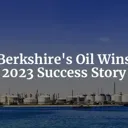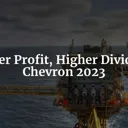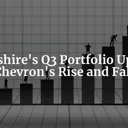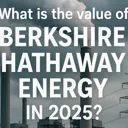Tags: Chevron
This fanpage is not officially affiliated with Berkshire Hathaway: Disclaimer
We discuss why Chevron is a good investment for Berkshire Hathaway in 2023 and beyond, highlighting Chevron's strong financial performance, competitive advantages, and growth opportunities in areas such as the Permian Basin, LNG business, renewable energy investments, and strategic acquisitions.
The company's diversified portfolio, commitment to innovation, and alignment with Berkshire Hathaway's long-term investment philosophy make it an attractive investment, estimated to generate an average annual return of 6% to 8% over the next years.
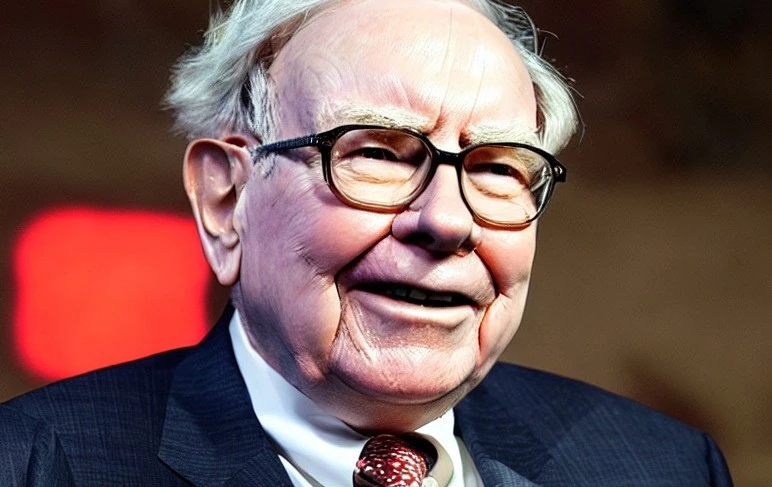
Introduction
Chevron Corporation is one of the world's largest integrated energy companies, with operations in more than 180 countries. It produces and transports crude oil and natural gas, refines and markets petroleum products, generates power, and develops and deploys technologies to enhance its performance and lower its environmental impact. Berkshire Hathaway Inc. is a holding company that owns a diverse portfolio of businesses, ranging from insurance and reinsurance to railroads and utilities.
Chevron also invests in various sectors, such as consumer goods, technology, and energy. Both Chevron and Berkshire Hathaway are leaders in their respective industries, with strong financial performance, competitive advantages, and long-term growth prospects. In 2020, Berkshire Hathaway invested $4.1 billion in Chevron, acquiring a 2.5% stake in the energy giant. In 2021, it increased its stake by 20%, making Chevron one of its largest holdings worth around $28 billion (165 million shares) as of April 2023 Berkshire Hathaway's Chevron Stake.
In this article, we will explore why Chevron is a great investment for Berkshire Hathaway in 2023, and how it aligns with its strategy and vision.
Chevron's Financial Performance 2022
Chevron has demonstrated its resilience and strength in 2022 and 2023, despite the adverse impacts of the Covid-19 pandemic, low oil prices, and environmental regulations on the energy industry. The company has improved its financial performance across several key metrics, such as revenue, earnings, cash flow, dividends, and debt reduction.
According to its annual report 2022, Chevron reported full-year 2022 earnings of $35.5 billion ($18.28 per share - diluted), compared with $15.6 billion ($8.14 per share - diluted) in 2021. Adjusted earnings of $36.5 billion ($18.83 per share - diluted) in 2022 compared to adjusted earnings of $15.6 billion ($8.13 per share - diluted) in 2021. The company also increased its quarterly dividend per share by 6% in 2022 and repurchased $11.25 billion in shares in 2022, returning excess cash to stockholders.
Chevron also generated strong cash flow from its operations, which enabled it to invest with discipline in oil, natural gas and new energy opportunities, as well as to strengthen its balance sheet. The company lowered its net debt ratio to 3.3% in 2022, down from 17% in 2020. Chevron also reduced its greenhouse gas emissions intensity by 7% in 2022, compared to its 2016 baseline, and committed to invest $10 billion in lower carbon businesses by 2028.
Chevron's financial performance reflects its strategy to leverage its strengths to safely deliver lower carbon energy to a growing world, while innovating for today and tomorrow.
Chevron's Competitive Advantages
Chevron is one of the leading oil and gas companies in the world, with a strong brand value and a diversified portfolio of assets. Chevron has maintained its competitive advantages over its peers, such as Exxon Mobil, BP, and Shell, by focusing on some of the factors that differentiate it from other players in the industry.
One of these factors is operational efficiency. Chevron has invested in improving its operational performance and reliability, reducing its downtime and costs, and increasing its production and reserves. Chevron has also leveraged its technological capabilities and innovation to enhance its exploration and production activities, as well as its refining and marketing operations.
Another factor that gives Chevron an edge over its competitors is cost discipline. Chevron has implemented rigorous capital allocation and cost management strategies, prioritizing high-return projects and optimizing its capital spending. Chevron has also reduced its operating expenses and lowered its breakeven price, making it more resilient to market volatility and price fluctuations.
A third factor that distinguishes Chevron from its rivals is its diversified portfolio. Chevron has a balanced mix of upstream and downstream businesses, as well as a presence in renewable energy sources, such as biofuels, solar, wind, and hydrogen. Chevron has also diversified its geographic footprint, operating in various regions and markets around the world, including North America, Latin America, Europe, Africa, Asia-Pacific, and Australia.
A fourth factor that contributes to Chevron's competitive advantage is innovation. Chevron has been at the forefront of developing and deploying new technologies and solutions that enhance its operational efficiency, environmental performance, and customer satisfaction. Chevron has also fostered a culture of innovation and collaboration within its organization, encouraging its employees to generate new ideas and share best practices.
A fifth factor that sets Chevron apart from its peers is social responsibility. Chevron has been committed to operating in a safe, ethical, and sustainable manner, respecting the environment and the communities where it operates. Chevron has also supported various social and economic development initiatives, such as education, health, energy access, and human rights.
These are some of the factors that have enabled Chevron to maintain its competitive advantages over its peers in the oil and gas industry. By focusing on these factors, Chevron has delivered superior results and value to its shareholders, customers, employees, and stakeholders.
Chevron’s Growth Opportunities
Chevron is one of the largest and most diversified energy companies in the world, with a strong portfolio of assets and operations across the globe. The company has a proven track record of delivering value to its shareholders, customers, and communities, while also advancing its environmental, social, and governance (ESG) goals. In 2023 and beyond, Chevron has several growth opportunities that will enhance its competitive position and generate attractive returns.
One of the key growth drivers for Chevron is its presence in the Permian Basin, the most prolific oil and gas region in the United States. Chevron has a leading position in the Permian, with over 2.2 million net acres and an estimated resource base of over 16 billion barrels of oil equivalent. The company plans to increase its production in the Permian from about 600,000 barrels per day in 2021 to over 900,000 barrels per day by 2025, while also reducing its carbon intensity and water usage. Chevron’s Permian operations are highly efficient and profitable, with low breakeven prices and high margins. However, Chevron reduced its Permian rig count from 16 to 7 in 2020 due to the pandemic and low oil prices cf. chevron.com, and faces competition from other major players in the region such as ExxonMobil and ConocoPhillips.
Another growth opportunity for Chevron is its liquefied natural gas (LNG) business, which provides a cleaner and more flexible source of energy for the global market. Chevron has a strong portfolio of LNG projects, including the Gorgon and Wheatstone projects in Australia, the Angola LNG project in Africa, and the Kitimat LNG project in Canada. The company expects to increase its LNG production from about 9 million tonnes per year in 2021 to over 12 million tonnes per year by 2025, while also exploring new markets and customers. Chevron also has LNG offtake agreements with US-based Venture Global and Cheniere, totaling 4 million tonnes per year between 2023 and 2042 ICIS.com, and is investing in lower carbon LNG fleet modification projects to reduce its emissions and fuel consumption, gasprocessingnews.com.
Chevron’s LNG projects are long-term and capital-intensive, but they offer stable cash flows and attractive returns.
A third growth opportunity for Chevron is its renewable energy investments, which support its ambition to be a net-zero emissions company by 2050. Chevron is investing in various forms of renewable energy, such as solar, wind, biofuels, hydrogen, and carbon capture and storage. The company aims to grow its renewable power generation capacity from about 3 gigawatts in 2021 to over 10 gigawatts by 2030, while also increasing its low-carbon fuels production from about 40 million gallons per year in 2021 to over 100 million gallons per year by 2030 CNBC on Renewable Energy Group Acquisition. Chevron’s renewable energy investments are aligned with its core competencies and capabilities, and they create value for its stakeholders.
A fourth growth opportunity for Chevron is its strategic acquisitions and partnerships, which enhance its portfolio and capabilities. Chevron has a history of making smart and disciplined deals that create synergies and efficiencies. In 2021, Chevron acquired Noble Energy, a leading independent oil and gas company with assets in the Permian Basin, the Eastern Mediterranean, and West Africa. The acquisition added about 18% to Chevron’s proved reserves and about 7% to its production, while also generating cost savings and operational improvements. Chevron also formed partnerships with various companies and organizations to advance its innovation and technology agenda, such as Microsoft, Google, Schlumberger, Baker Hughes, TotalEnergies, Shell, BP, ExxonMobil, and the Oil and Gas Climate Initiative.
Chevron has multiple growth opportunities that will strengthen its position as a leading energy company. Chevron’s growth opportunities include expanding its presence in the Permian Basin, developing its LNG projects, increasing its renewable energy investments, and pursuing strategic acquisitions and partnerships. These opportunities will enable Chevron to deliver superior performance and returns to its shareholders, while also contributing to the energy transition and addressing the climate challenge.
Conclusion
We have discussed why Chevron is a good investment for Berkshire Hathaway in 2023. We have shown how Chevron has a strong competitive advantage in the energy sector, with a diversified portfolio of assets, a resilient balance sheet, and a commitment to innovation and sustainability. We have also explained how Chevron fits well with Berkshire Hathaway’s long-term investment philosophy, which seeks value, growth, and income potential in companies that have durable competitive advantages and strong management teams.
We may speculate that Chevron will generate an attractive average annual return of 6% to 8% over the next few years, with a dividend yield of 4-5% at a price-to-earnings ratio of around 15 for estimated earnings per share at $12. This might imply a fair value of $180...$190 per share by the end of 2023, still representing a considerable upside from the current price of $169 (April 21st 2023), which is significantly below Berkshire's historic acquisition price for Chevron stocks.
Therefore, we conclude that Chevron is a good investment for Berkshire Hathaway in 2023 and beyond.
Appendix: Chevron 2022 Key Financials
| Financial Metric | 2022 | 2021 | % Change |
|---|---|---|---|
| Revenue ($ billion) | 181.8 | 94.4 | 92.6% |
| Earnings ($ billion) | 35.5 | 15.6 | 127.6% |
| Earnings per share ($) | 18.28 | 8.14 | 124.3% |
| Cash flow from operations ($ billion) | 51.7 | 17.9 | 188.8% |
| Cash dividends per share ($) | 5.36 | 5.16 | 3.9% |
| Total assets ($ billion) | 237.9 | 237.4 | 0.2% |
